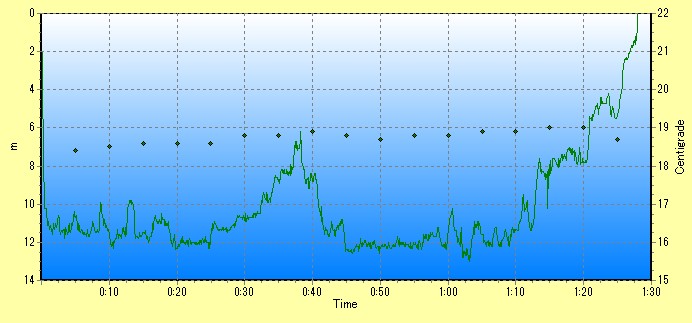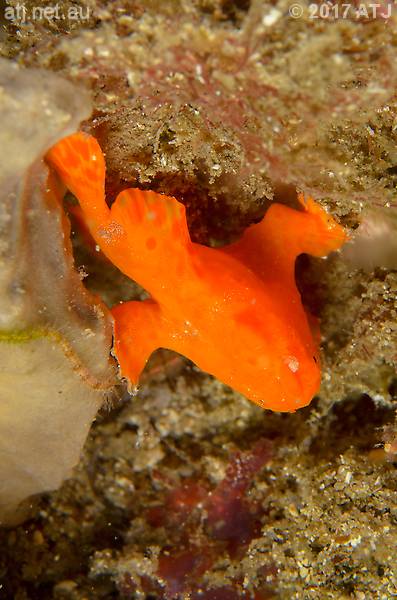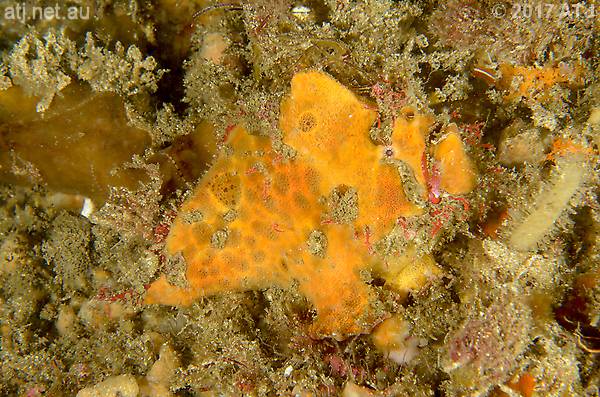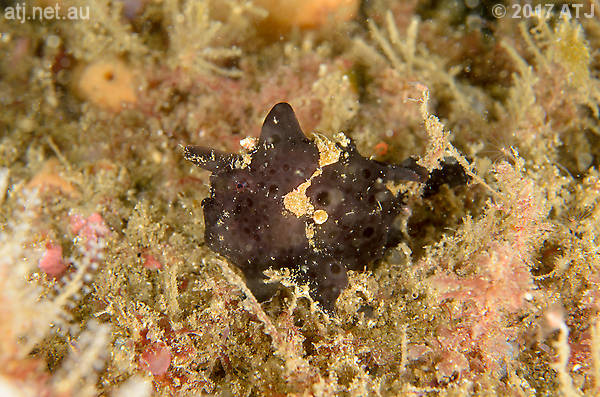Dive Details
Location
Date
Saturday 1 July 2017
Time
11:44am - 1:12pm
Details
The swell was forecast to be up to 3 metres today but as it was from the south we'd new we'd be OK at The Monument. Even The Steps weren't too bad. There was a fairly large group of us because we were going to surprise Dama after the dive for her birthday on Monday.
We walked along the rocks towards The Steps and got in at the platform between The Monument and The Steps. It was a little tricky because it is shallow over the platform and a wave would come through every now and then. Once we were all in we descended and swam to the sand line. Visibility was only 3 to 5 metres but considering the swell this wasn't a surprise. The water temperature was around 18.5°C. There was some surge but it wasn't all that strong, which was a surprise. We turned left and headed towards The Monument.
We swam along the sand line and just past Block Rock I found the small orange painted angler. This angler looks bigger each time I see it.
At the start of the Deep Wall I spotted a large orange red-fingered anglerfish pressed into the wall. This may be the same one that was on top of the wall a few weeks ago.
Further along the wall I found the black painted anglerfish. It was ambling along the top of the rock.
We continued along the wall and after the end of the wall I looked for pygmy pipehorses on the Carijoa covered rock. I found the pink male but was not able to find any others. I showed it to Donna. As I headed up to the other rock with pygmies, Kim and Donna showed me two pygmies on a rock to the south-east of the usual rock. I then checked the usual rock and found a cryptic male.
We swam up the rock with the seahorses. On the way up Kim pointed out a Tambja tenuilineata nudibranch. At the seahorses, I found the female on the side of the rock and then found the male on top of the rock. I showed them to Kim.
Mike had just come down from the cowries so I headed up to the Capnella colonies. Both cowries were out in the open and easy to find. I pointed them out to Kim - not that I needed to.
I went back to the seahorses. Mike hadn't found the female so I showed her to him.
Kim and I then headed back down the reef and made our way slowly to Four Pygmies Rock via Split Rock. We didn't find anything interesting along the way. At Four Pygmies Rock I was extremely disappointed to find that the red finger sponge in which the red male pygmy pipehorse has been living for the past 4 months was gone. I don't understand what could have happened to the sponge. It had been there only a few days ago and was in good condition. There was no sign of the red pygmy on the rock. I also couldn't find the female. I looked around at adjacent rocks and found the female on the rock towards the North-South Wall.
I looked around the area for other interesting things and found a large Nembrotha purpureolineata to the north of Four Pygmies Rock. Kim found a blenny hiding in a hole.
Kim and I headed up the North-South Wall and swam towards the base of the East-West wall. I found another large Nembrotha purpureolineata nudibranch on the way. We headed to the top of the wall and started our safety stop as we swam west. I figured it would be safer getting out on the inside of Sutherland Point. We surfaced 20 metres from the shore and had to wade across uneven rocks to the shore.
Buddy
Kim Dinh, Mike Scotland, Donna Cassidy, Ron Walsh, Roney & Dama Rodrigues
Seas
Slight
Visibility
3 to 5 metres
Duration
88 minutes
Maximum depth
13.1 m
Average depth
10.2 m
Water temperature
18.4°C
Dive Profile from Citizen Hyper Aqualand

Tides at Botany Bay AEST
Note that tides at dive site may vary from above location.
High
1:42am
1.52m
Low
8:20am
0.53m
High
2:45pm
1.45m
Low
8:43pm
0.76m
Camera gear
Camera
Nikon D7000
Lens
Nikon AF-S Micro Nikkor 60mm f/2.8G ED
Housing
Ikelite 6801.70
Lens port
Ikelite Flat Port 5502.41
Strobe
2 x Ikelite SubStrobe DS161
Photographs
Depth information, where present, indicates the depth of the camera when the photograph was taken and can be used to approximate the depth of the subject.

Painted anglerfish, Antennarius pictus. 11.6 m.

Red-fingered angler, Porophryne erythrodactylus. 11.7 m.

Painted anglerfish, Antennarius pictus. 11.1 m.